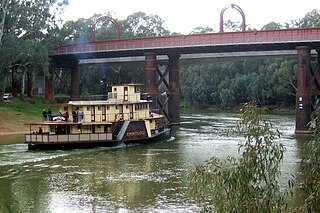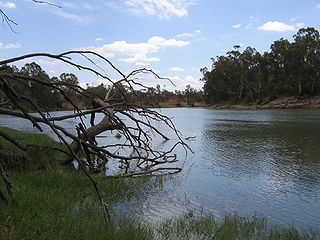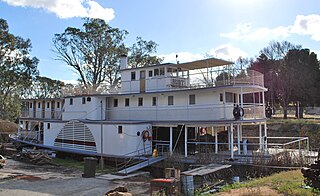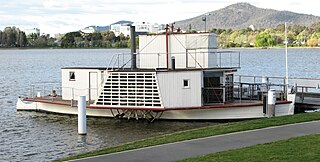
The Murray River is a river in Southeastern Australia. It is Australia's longest river at 2,508 km (1,558 mi) extent. Its tributaries include five of the next six longest rivers of Australia. Together with that of the Murray, the catchments of these rivers form the Murray–Darling basin, which covers about one-seventh the area of Australia. It is widely considered Australia's most important irrigated region.

Echuca is a town on the banks of the Murray River and Campaspe River in Victoria, Australia. The border town of Moama is adjacent on the northern side of the Murray River in New South Wales. Echuca is the administrative centre and largest settlement in the Shire of Campaspe. As of the 2021 census, Echuca had a population of 15,056, and the population of the combined Echuca and Moama townships was 22,568.

A paddle steamer is a steamship or steamboat powered by a steam engine that drives paddle wheels to propel the craft through the water. In antiquity, paddle wheelers followed the development of poles, oars and sails, where the first uses were wheelers driven by animals or humans.

Boundary Bend is a small town in the state of Victoria, Australia. It is near the junction of the Murray River and Murrumbidgee River. It is located about 50 kilometres east along the Murray Valley Highway from the twin towns of Robinvale in Victoria and Euston in New South Wales, about 90 km north of Swan Hill. At the 2016 census, Boundary Bend and the surrounding area had a population of 132.

The PS Oscar W is a restored paddle steamer located at Goolwa in South Australia.

The Alexander Arbuthnot is the last paddle steamer built as a working boat during the riverboat trade era on the Murray River, Australia.

Barham is a town in the western Riverina district of New South Wales, Australia. The town is located 823 kilometres south west of the state capital, Sydney and 303 kilometres north west of Melbourne. Situated on the banks of the Murray River across from Koondrook in the neighbouring state of Victoria, Barham had a population of 1,159 at the 2016 census. The town is in the Murray River Council local government area.

The PS Ruby, also known as the Paddle Steamer Ruby is the flagship of the historic port of Wentworth, New South Wales at the junction of the Murray and Darling Rivers. She is a composite hull paddle steamer that features a 1926 Robey & Co 20 nominal horsepower portable steam engine. Between 1996 and 2007 she was restored to her early 20th-century appearance.

PS Adelaide is the second oldest wooden hulled paddle steamer still operating anywhere in the world. Hjejlen from Denmark is older and have sailed since 1861 It is now moored at the Echuca Wharf and used for special occasions.

PS Success is a historic paddle steamer in Victoria, Australia. Originally built as a snagging steamer in June 1877, it is currently being restored by the Port of Echuca to full working order. When operational, it will be added to the fleet of paddle steamers at Echuca Wharf.

PS Pevensey is a historic paddle steamer, with its original steam engine, in the fleet of steamers at Echuca Wharf, Victoria, Australia. Built in 1911, it traded on the Murray River until about 1958. In 1973 it was brought by Echuca for restoration and now operates as a tourist boat.

PS Canberra is an original paddle steamer operated by Murray River Paddlesteamers in Echuca.

PV Pride of the Murray, like many other Australian paddle wheelers, started out life as a timber logging barge. It was built at Echuca on the Murray River in 1924, and relaunched as a tourist vessel in 1977, also at Echuca. In 2022 the vessel was transported overland to Longreach, Queensland, for use as a tourist attraction on the Thompson River.
This is a list of captains and boat owners and others important in the history of the Murray-Darling steamer trade, predominantly between 1850 and 1950.

PS Enterprise is an 1878 Australian paddle steamer, currently owned by the National Museum of Australia in Canberra. It is still operational, and one of the oldest working paddle steamers in the world. It is listed on the Australian Register of Historic Vehicles.
PS Rodney is a heritage-listed paddle steamer shipwreck on the Darling River at Polia Station, Pooncarie in the Wentworth Shire, New South Wales, Australia. It was designed by Captains Dorward and Davies and built by Thomas McDonald. The property is owned by Department of Trade & Investment, Regional Infrastructure & Services, an agency of the Government of New South Wales. It was added to the New South Wales State Heritage Register on 23 November 2007.

The PS Gem is a retired side-wheel paddle steamer that was first launched in 1876 on the Murray River at Moama, New South Wales. She operated as a cargo and passenger steamer, regularly cruising between Morgan and Mildura. The Gem operated as a tourist passenger vessel during the 1930s and 1940s, and was retired in the early 1950s. In 1962 the Gem was sold to the then Swan Hill Folk Museum, where it would become a static display and historic monument.

The PV Pyap is a tourist paddle vessel operating within Swan Hill's Pioneer Settlement. Originally launched as a barge in July 1896 at Mannum, the Pyap was completed as a paddle steamer in late 1897 and operated on the Murray River. In 1970, the Pyap was purchased by Toby Henson and refitted with a diesel enginge, with the intention of relocation to the Pioneer Settlement.

The PV Amphibious is a diesel-powered paddle vessel based in Echuca, Victoria. She was constructed in Melbourne in 1875 by Bevan & Cooke, and started life as a screw steamer in 1876.


















